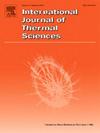Numerical analysis of heat and flow transfer in permeable textile ensemble in windy conditions
IF 4.9
2区 工程技术
Q1 ENGINEERING, MECHANICAL
International Journal of Thermal Sciences
Pub Date : 2025-06-28
DOI:10.1016/j.ijthermalsci.2025.110105
引用次数: 0
Abstract
A three-dimensional geometric model of cold protective clothing was proposed, which consisted of a thin windproof layer and a thick insulation layer. The heat transfer and airflow movement within textile ensembles under different various conditions were simulated using a computational fluid dynamic (CFD) method. The simulation process considered natural convection occurring within the environment and the textile, as well as forced convection induced by the infiltration of ambient air into the textile. The effects of wind velocity, outer-layer permeability and inner-layer penetrability on thermal insulation properties of the textile ensembles were investigated. In addition, temperature distribution and airflow streamlines were utilized to examine the internal heat transfer and airflow movement mechanisms in windy conditions, with a particular focus on the interaction between multi-layer permeability and airflow. The finding indicated that reducing the permeability of the outer layer was found to advantageously minimize internal air movement and forced convection heat loss. In addition, in windy conditions, the thermal insulation of textiles with higher outer-layer permeability was dependent on the penetrability of the inner layer. Notably, combination textiles with a lower inner-layer permeability exhibited better thermal insulation performance compared to combination textiles with higher permeability. The obtained research findings offer a fresh perspective on cold protective clothing design, providing a theoretical foundation for optimizing clothing thermal performance by considering the interaction between different layers' permeability.
有风条件下透水织物整体热流传递的数值分析
提出了一种由薄防风层和厚保温层组成的防寒服三维几何模型。采用计算流体力学(CFD)方法对不同工况下纺织系统内部的传热和气流运动进行了数值模拟。模拟过程考虑了环境和纺织品内发生的自然对流,以及环境空气渗透到纺织品中引起的强迫对流。研究了风速、外层透气性和内层透气性对纺织服装保温性能的影响。此外,利用温度分布和气流流线来研究有风条件下的内部传热和气流运动机制,特别关注多层透气性和气流之间的相互作用。研究结果表明,降低外层的渗透率有利于减少内部空气运动和强制对流热损失。此外,在多风条件下,外层透气性较高的纺织品的保温效果取决于内层的透气性。值得注意的是,与具有较高渗透率的组合纺织品相比,具有较低内层渗透率的组合纺织品具有更好的隔热性能。研究结果为防寒服装设计提供了新的视角,为考虑不同层间透气性的相互作用来优化服装热性能提供了理论基础。
本文章由计算机程序翻译,如有差异,请以英文原文为准。
求助全文
约1分钟内获得全文
求助全文
来源期刊

International Journal of Thermal Sciences
工程技术-工程:机械
CiteScore
8.10
自引率
11.10%
发文量
531
审稿时长
55 days
期刊介绍:
The International Journal of Thermal Sciences is a journal devoted to the publication of fundamental studies on the physics of transfer processes in general, with an emphasis on thermal aspects and also applied research on various processes, energy systems and the environment. Articles are published in English and French, and are subject to peer review.
The fundamental subjects considered within the scope of the journal are:
* Heat and relevant mass transfer at all scales (nano, micro and macro) and in all types of material (heterogeneous, composites, biological,...) and fluid flow
* Forced, natural or mixed convection in reactive or non-reactive media
* Single or multi–phase fluid flow with or without phase change
* Near–and far–field radiative heat transfer
* Combined modes of heat transfer in complex systems (for example, plasmas, biological, geological,...)
* Multiscale modelling
The applied research topics include:
* Heat exchangers, heat pipes, cooling processes
* Transport phenomena taking place in industrial processes (chemical, food and agricultural, metallurgical, space and aeronautical, automobile industries)
* Nano–and micro–technology for energy, space, biosystems and devices
* Heat transport analysis in advanced systems
* Impact of energy–related processes on environment, and emerging energy systems
The study of thermophysical properties of materials and fluids, thermal measurement techniques, inverse methods, and the developments of experimental methods are within the scope of the International Journal of Thermal Sciences which also covers the modelling, and numerical methods applied to thermal transfer.
 求助内容:
求助内容: 应助结果提醒方式:
应助结果提醒方式:


